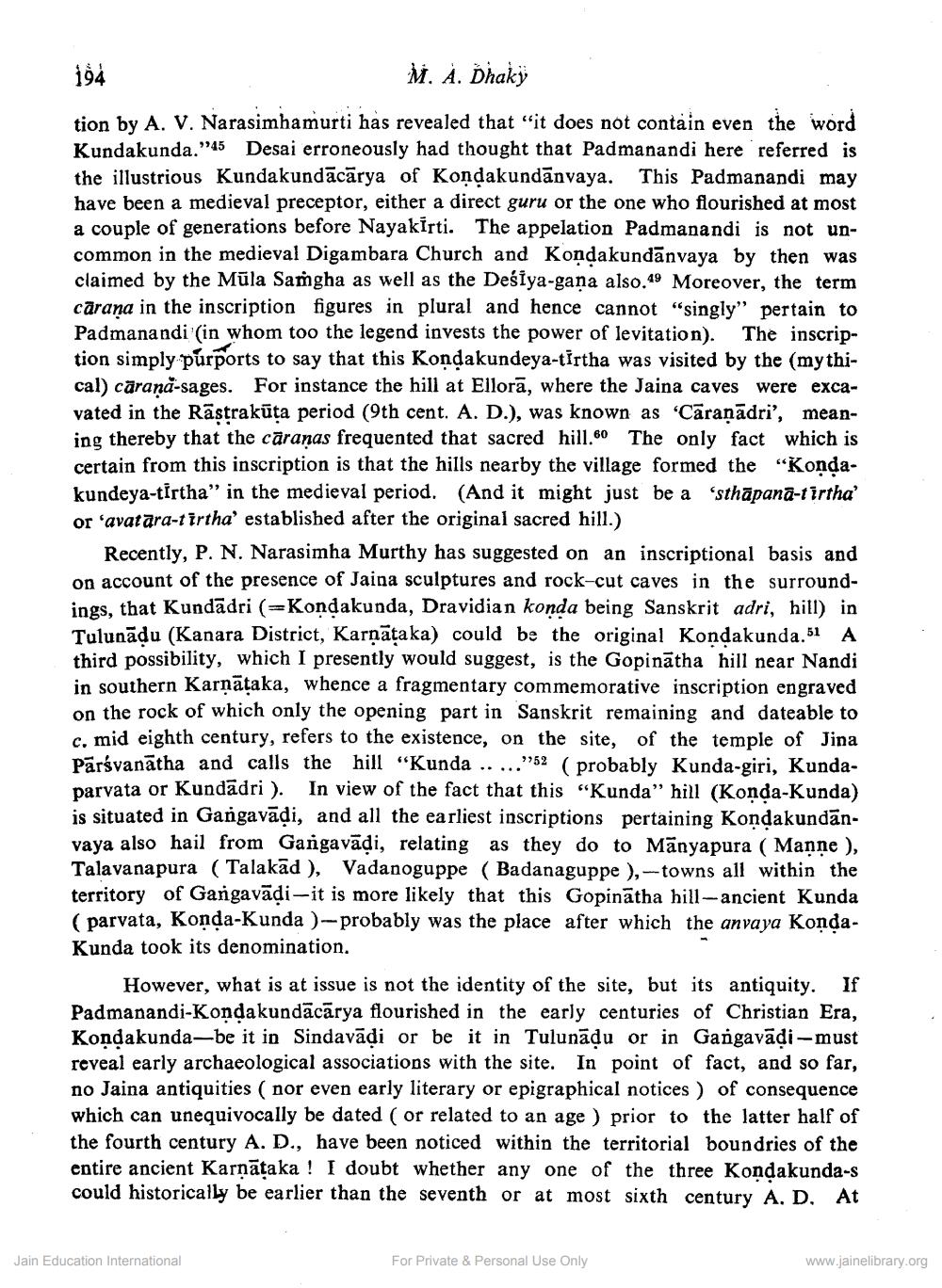Book Title: Date of Kundakundacharya Author(s): M A Dhaky Publisher: Z_Aspect_of_Jainology_Part_3_Pundit_Dalsukh_Malvaniya_012017.pdf View full book textPage 8
________________ 194 M. A. Dhaky 49 tion by A. V. Narasimhamurti has revealed that "it does not contain even the word Kundakunda."45 Desai erroneously had thought that Padmanandi here referred is the illustrious Kundakundācārya of Kondakundanvaya. This Padmanandi may have been a medieval preceptor, either a direct guru or the one who flourished at most a couple of generations before Nayakirti. The appelation Padmanandi is not uncommon in the medieval Digambara Church and Kondakundanvaya by then was claimed by the Müla Samgha as well as the Deślya-gana also. Moreover, the term caraṇa in the inscription figures in plural and hence cannot "singly" pertain to Padmanandi (in whom too the legend invests the power of levitation). The inscription simply purports to say that this Kondakundeya-tirtha was visited by the (mythical) caraṇa-sages. For instance the hill at Ellora, where the Jaina caves were excavated in the Rastrakūta period (9th cent. A. D.), was known as 'Caraṇādri', meaning thereby that the caranas frequented that sacred hill. The only fact which is certain from this inscription is that the hills nearby the village formed the "Kondakundeya-tirtha" in the medieval period. (And it might just be a 'sthāpanā-tirtha' or 'avatara-tirtha' established after the original sacred hill.) Recently, P. N. Narasimha Murthy has suggested on an inscriptional basis and on account of the presence of Jaina sculptures and rock-cut caves in the surroundings, that Kundadri (-Kondakunda, Dravidian konda being Sanskrit adri, hill) in Tulunadu (Kanara District, Karnataka) could be the original Kondakunda.51 A third possibility, which I presently would suggest, is the Gopinatha hill near Nandi in southern Karnataka, whence a fragmentary commemorative inscription engraved on the rock of which only the opening part in Sanskrit remaining and dateable to c. mid eighth century, refers to the existence, on the site, of the temple of Jina Parsvanatha and calls the hill "Kunda...... 9752 (probably Kunda-giri, Kundaparvata or Kundadri ). In view of the fact that this "Kunda" hill (Konda-Kunda) is situated in Gangavaḍi, and all the earliest inscriptions pertaining Kondakundanvaya also hail from Gangavaḍi, relating as they do to Manyapura (Manne), Talavanapura (Talakad), Vadanoguppe (Badanaguppe ),-towns all within the territory of Gangavaḍi-it is more likely that this Gopinatha hill-ancient Kunda (parvata, Konda-Kunda )-probably was the place after which the anvaya KondaKunda took its denomination. However, what is at issue is not the identity of the site, but its antiquity. If Padmanandi-Koṇḍakundacārya flourished in the early centuries of Christian Era, Kondakunda-be it in Sindavāḍi or be it in Tulunadu or in Gangavāḍi-must reveal early archaeological associations with the site. In point of fact, and so far, no Jaina antiquities (nor even early literary or epigraphical notices) of consequence which can unequivocally be dated (or related to an age) prior to the latter half of the fourth century A. D., have been noticed within the territorial boundries of the entire ancient Karnataka! I doubt whether any one of the three Kondakunda-s could historically be earlier than the seventh or at most sixth century A. D. At Jain Education International For Private & Personal Use Only www.jainelibrary.orgPage Navigation
1 ... 6 7 8 9 10 11 12 13 14 15 16 17 18 19 20
